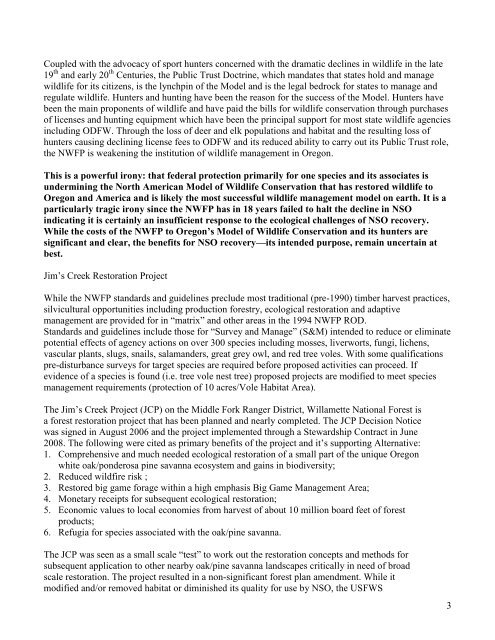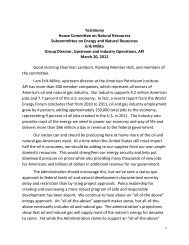Mr. Stephen Mealey - The House Committee on Natural Resources ...
Mr. Stephen Mealey - The House Committee on Natural Resources ...
Mr. Stephen Mealey - The House Committee on Natural Resources ...
You also want an ePaper? Increase the reach of your titles
YUMPU automatically turns print PDFs into web optimized ePapers that Google loves.
Coupled with the advocacy of sport hunters c<strong>on</strong>cerned with the dramatic declines in wildlife in the late<br />
19 th and early 20 th Centuries, the Public Trust Doctrine, which mandates that states hold and manage<br />
wildlife for its citizens, is the lynchpin of the Model and is the legal bedrock for states to manage and<br />
regulate wildlife. Hunters and hunting have been the reas<strong>on</strong> for the success of the Model. Hunters have<br />
been the main prop<strong>on</strong>ents of wildlife and have paid the bills for wildlife c<strong>on</strong>servati<strong>on</strong> through purchases<br />
of licenses and hunting equipment which have been the principal support for most state wildlife agencies<br />
including ODFW. Through the loss of deer and elk populati<strong>on</strong>s and habitat and the resulting loss of<br />
hunters causing declining license fees to ODFW and its reduced ability to carry out its Public Trust role,<br />
the NWFP is weakening the instituti<strong>on</strong> of wildlife management in Oreg<strong>on</strong>.<br />
This is a powerful ir<strong>on</strong>y: that federal protecti<strong>on</strong> primarily for <strong>on</strong>e species and its associates is<br />
undermining the North American Model of Wildlife C<strong>on</strong>servati<strong>on</strong> that has restored wildlife to<br />
Oreg<strong>on</strong> and America and is likely the most successful wildlife management model <strong>on</strong> earth. It is a<br />
particularly tragic ir<strong>on</strong>y since the NWFP has in 18 years failed to halt the decline in NSO<br />
indicating it is certainly an insufficient resp<strong>on</strong>se to the ecological challenges of NSO recovery.<br />
While the costs of the NWFP to Oreg<strong>on</strong>’s Model of Wildlife C<strong>on</strong>servati<strong>on</strong> and its hunters are<br />
significant and clear, the benefits for NSO recovery—its intended purpose, remain uncertain at<br />
best.<br />
Jim’s Creek Restorati<strong>on</strong> Project<br />
While the NWFP standards and guidelines preclude most traditi<strong>on</strong>al (pre-1990) timber harvest practices,<br />
silvicultural opportunities including producti<strong>on</strong> forestry, ecological restorati<strong>on</strong> and adaptive<br />
management are provided for in “matrix” and other areas in the 1994 NWFP ROD.<br />
Standards and guidelines include those for “Survey and Manage” (S&M) intended to reduce or eliminate<br />
potential effects of agency acti<strong>on</strong>s <strong>on</strong> over 300 species including mosses, liverworts, fungi, lichens,<br />
vascular plants, slugs, snails, salamanders, great grey owl, and red tree voles. With some qualificati<strong>on</strong>s<br />
pre-disturbance surveys for target species are required before proposed activities can proceed. If<br />
evidence of a species is found (i.e. tree vole nest tree) proposed projects are modified to meet species<br />
management requirements (protecti<strong>on</strong> of 10 acres/Vole Habitat Area).<br />
<str<strong>on</strong>g>The</str<strong>on</strong>g> Jim’s Creek Project (JCP) <strong>on</strong> the Middle Fork Ranger District, Willamette Nati<strong>on</strong>al Forest is<br />
a forest restorati<strong>on</strong> project that has been planned and nearly completed. <str<strong>on</strong>g>The</str<strong>on</strong>g> JCP Decisi<strong>on</strong> Notice<br />
was signed in August 2006 and the project implemented through a Stewardship C<strong>on</strong>tract in June<br />
2008. <str<strong>on</strong>g>The</str<strong>on</strong>g> following were cited as primary benefits of the project and it’s supporting Alternative:<br />
1. Comprehensive and much needed ecological restorati<strong>on</strong> of a small part of the unique Oreg<strong>on</strong><br />
white oak/p<strong>on</strong>derosa pine savanna ecosystem and gains in biodiversity;<br />
2. Reduced wildfire risk ;<br />
3. Restored big game forage within a high emphasis Big Game Management Area;<br />
4. M<strong>on</strong>etary receipts for subsequent ecological restorati<strong>on</strong>;<br />
5. Ec<strong>on</strong>omic values to local ec<strong>on</strong>omies from harvest of about 10 milli<strong>on</strong> board feet of forest<br />
products;<br />
6. Refugia for species associated with the oak/pine savanna.<br />
<str<strong>on</strong>g>The</str<strong>on</strong>g> JCP was seen as a small scale “test” to work out the restorati<strong>on</strong> c<strong>on</strong>cepts and methods for<br />
subsequent applicati<strong>on</strong> to other nearby oak/pine savanna landscapes critically in need of broad<br />
scale restorati<strong>on</strong>. <str<strong>on</strong>g>The</str<strong>on</strong>g> project resulted in a n<strong>on</strong>-significant forest plan amendment. While it<br />
modified and/or removed habitat or diminished its quality for use by NSO, the USFWS<br />
3
















